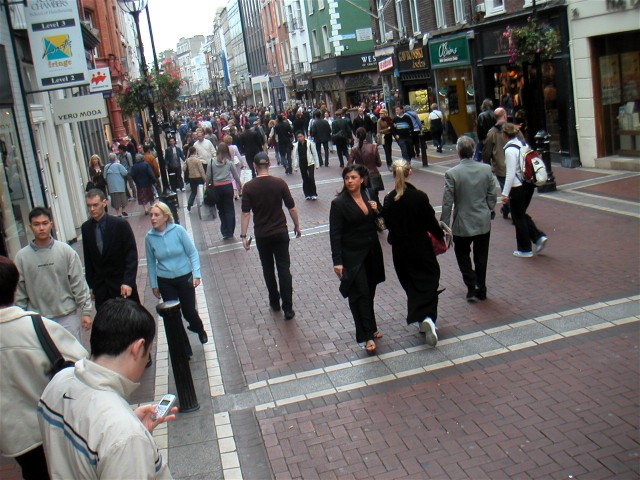 |
| Manske, Mangus. "People on Grafton Street, Dublin, Ireland." 8/14/06 via Wikimedia Commons. Public Domain License. |
Since QRGs exist online, their format must reflect that media. QRGs share many of the same conventions as blogs and online newspaper articles. It is up to the author to adhere to these conventions through different formatting. The author must format a QRG in short paragraphs with white space in between. This helps the reader manage a large amount of text without feeling overwhelmed. Authors also give QRGs a short lead/introduction that lays out what the article will be about.
Other conventions of QRGs include containing many hyperlinks, which is another advantage of working with online media. Hyperlinks provide additional information, and give credibility to the article. Additionally, QRGs are broken up into sections, each with a subheading, which is usually phrased as a question. Questions keep the reader engaged, while also allowing the reader to skip around to read the sections that are interesting to him/her. Most of the conventions of a QRG exist to make it easier for the reader. The author can influence the reader by opinions, questions, and organization, but the author must keep the reader engaged.
The intended audience for a QRG is the general public. QRGs are not written with academic language, but instead with an informal tone and commonplace vocabulary. They have a narrative feel to them. Although the example QRGs about Bernie Sanders, e-cigerettes, Gamergate, Sochi's Opening Ceremony, and Greece's economy are all on very different topics, the audience is still mostly the same, making up the common, everyday population of American citizens. Although some people might not be very interested in politics, or others don't smoke, these are still large enough issues they are relevant to the general public.
A person reading one of these QRGs could just as easily be interested in another. They are on topics that many people invest time in, such as presidential campaigns, and the Olympics. They are all written with the same casual tone that doesn't require rigorous academic engagement. Although they include opinions, they are most informative and not inflammatory or provocative, which widens the audience. QRGs are meant for such a large and general audience, because their purpose is to provide information and some analysis on a relevant issue, and they aim to educate as many people possible.
QRGs use graphics and visuals for a number of reasons. The main purpose of an image is to highlight important information in a different way besides text. This can be a graph, a picture, or even a quote in larger letters and a different font. People are naturally drawn to images, and it helps them to process an idea presented: it makes the idea more concrete. Often providing pictures of relevant people helps the reader form judgement about that person, without the author having to explicitly state them. Images can often convey strong emotions, and the author doesn't have to tell the person how to feel, which is not an effective technique.
Social media clips, like a screenshot of a Twitter post, can provide more information quickly than if the author were to describe the tweet in words. Graphics are also a nice break from large amounts of text. It gives the article variety, and makes it look more appealing.
REFLECTION
In reading responses, everyone had a different way of explaining hyperlinking, which made me realize the importance of using hyperlinks in a QRG. I realized before they were a good thing to include in an article, but by reading the different interpretations of why hyperlinking is important, with the aspect of citation, and the fact hyperlinking engages the reader. I also liked how Jon described QRGs as "condensed" rather than "dumbed down" because I think that phrase captured the style of a QRG more effectively than mine did, and it's an important aspect that QRGs are still very informative, and not just rudimentary. Also, I liked Chris's explanation of how images are supposed to "supplement" but not "overshadow" the issue. Images are very important, and can convey key points in a different media, but ultimately they should be supporting the main argument/idea.
Replies:
Jon
Chris
Stef
I agree with your conventions of QRGs. I also liked how you emphasized the importance of hyperlinking and the use of images when writing a QRG.
ReplyDeleteYou are just really really thourough and I'm super jealous of that! The only thing I would say is that QRGs are typically pretty quick reads and this one seemed a bit wordy, but the content is excellent.
ReplyDeleteI also had made the same claims as you. Our points of view are a little different, but essentially the same in the purpose they have in the QRGs. Honestly, I do not think you missed any convention of a QRG. Yours was very elaborate, but you write in a way that allows the reader to read easily.
ReplyDeleteThis post really captured the essence of a QRG very well. You covered exactly how the genre relates to the reader and how that is such a critical part of a QRG. I liked how you explained the purpose of each convention and how that adds to the effectiveness of the work. This blog is very in-depth and very comprehensive. Nice job!
ReplyDelete